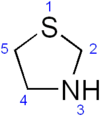Chemistry:Thiazolidine

| |
| Names | |
|---|---|
| Preferred IUPAC name
1,3-Thiazolidine[1] | |
| Identifiers | |
3D model (JSmol)
|
|
| ChemSpider | |
PubChem CID
|
|
| UNII | |
| |
| |
| Properties | |
| C3H7NS | |
| Molar mass | 89.16 g·mol−1 |
| Density | 1.131 g/cm3[2] |
| Boiling point | 72 to 75 °C (162 to 167 °F; 345 to 348 K)[2] at 25 torr |
Except where otherwise noted, data are given for materials in their standard state (at 25 °C [77 °F], 100 kPa). | |
| Infobox references | |
Thiazolidine is a heterocyclic organic compound with the formula (CH2)3(NH)S. It is a 5-membered saturated ring with a thioether group and an amine group in the 1 and 3 positions. It is a sulfur analog of oxazolidine. Thiazolidine is a colorless liquid. Although the parent thiazolidine is only of academic interest, some derivatives, i.e., the thiazolidines, are important, such as the antibiotic penicillin.
Preparation
Thiazolidine is prepared by the condensation of cysteamine and formaldehyde.[3] Other thiazolidines may be synthesized by similar condensations. A notable derivative is 4-carboxythiazolidine (thioproline), derived from formaldehyde and cysteine.
Derivatives
Useful thiazolidines include the drug pioglitazone, the antibiotic penicillin, and N-Methyl-2-thiazolidinethione, an accelerator for the vulcanization of chloroprene rubbers.[4]
Thiazolidines functionalized with carbonyls at the 2 and 4 positions, the thiazolidinediones, are drugs used in the treatment of diabetes mellitus type 2. Rhodanine is a related bioactive species, featuring one carbonyl and one thiocarbonyl.
Many thiazolidines are prepared from cysteine and related aminothiols.[5] p-aminocinnamaldehyde is able to differentiate between cysteine and homocysteine. With cysteine, a buffered water solution of the aldehyde changes from yellow to colorless due to a secondary ring closing reaction of the imine. Homocysteine is unable to give ring closure and the color does not change.
See also
References
- ↑ International Union of Pure and Applied Chemistry (2014). Nomenclature of Organic Chemistry: IUPAC Recommendations and Preferred Names 2013. The Royal Society of Chemistry. pp. 142. doi:10.1039/9781849733069. ISBN 978-0-85404-182-4.
- ↑ 2.0 2.1 Thiazolindine
- ↑ Ratner, Sarah; Clarke, H. T. (1937). "Action of formaldehyde on cysteine". Journal of the American Chemical Society 59: 200–6. doi:10.1021/ja01280a050.
- ↑ Rüdiger Schubart (2000). "Dithiocarbamic Acid and Derivatives". Ullmann's Encyclopedia of Industrial Chemistry. Weinheim: Wiley-VCH. doi:10.1002/14356007.a09_001. ISBN 3527306730.
- ↑ Wang, Weihua; Rusin, Oleksandr; Xu, Xiangyang; Kim, Kyu Kwang; Escobedo, Jorge O.; Fakayode, Sayo O.; Fletcher, Kristin A.; Lowry, Mark et al. (2005). "Detection of Homocysteine and Cysteine". Journal of the American Chemical Society 127 (45): 15949–15958. doi:10.1021/ja054962n. PMID 16277539.
 |



